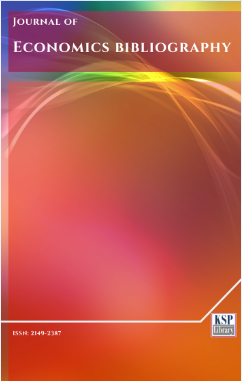South African Exchange Rate After 2000s: An Econometric Investigation
Abstract
Abstract. This paper is an econometric investigation, an analysis on the difficulty of modeling the South African exchange rate. The aim of the paper is to examine the nature of the existing relationship between the real exchange rate of the Rand, real prices of gold, platinum and the real interest rate differential through different empirical models, and this over the period going from January 2000 to September 2014. Our analysis shows that, over the same period, with different empirical methods, the variables used can be the determinants ofthe real value of the South African Rand, but at different horizons. To achieve our goals, longrun (Engle & Granger, 1987; Johansen, 1988) and short run (VAR process; Sims, 1980) analysis have been performed. We come to the conclusion that, the determinants of the Rand change according to the methods used and these do not therefore allow us to have robustresults. The long run analysis performed by Engle and Granger approach result to a lack of long run relationship among our variables. To have a robust idea on the lack of cointegrating relationship, we have performed another long run analysis: the vector error correction model (VECM approach) of Johansen which results on the existence of one cointegrating relation among real value of the Rand and their determinants. However, because of the lack of long run relationship resulting of the Engle & Granger approach, we have performed a short run analysis with the vector autoregressive process. We find that only the real platinum price in our study is a short term determinant of the real value of the Rand. The real impact is effective only at the end of the first quarter with a real appreciation of the Rand. The main surprise is the absence of impact of real price of gold shock on the real value of the Rand. Analyze the South African exchange rate through one empirical method/model to find their determinants can bebiased.
Keywords. Exchange rate, Raw materials, Vector Auto-Regressive, Co-integration.
JEL. C13, C58, D53, D81, G01, G02, G15, H63.
Keywords
References
Apergis, N., & Papoulakos, D. (2013). The Australian dollar and gold prices. The Open Economics Journal. 6, 1-10. doi. 10.2174/1874919401306010001
Cashin, P., Céspedes, L.F., & Sahay, R. (2004). Commodity currencies and the real exchange rate. Journal of Development Economics, 75(1), 239-268. doi. 10.1016/j.jdeveco.2003.08.005
Chen, Y., & Rogoff, K. (2003). Commodity currencies. Journal of International Economics, 60(1), 133 160. doi. 10.1016/S0022-1996(02)00072-7
Dumitrescu, E., Arezki, E., Freytag, A., & Quintyn, M. (2012). Commodity prices and exchange rate volatility: Lessons from south africa’s capital account liberalization. IMF Working Paper, No. 12/168.
Égert, B. (2012). Nominal and real exchange rate models in South Africa: How robust are they? CEsifoWorkingPaper No.3853, [Retrieved from].
Engle, R., & Granger, C. (1987). Co-integration and error correction: Representation, estimation, and testing. Econometrica, 55(2), 251-276. doi. 10.2307/1913236
Frankel, J. (2007). On the rand: Determinants of the South African exchange rate. South African Journal of Economics, 75(3), 425-441. doi. 10.1111/j.1813-6982.2007.00130.x
Granger, C. (1981). Some properties of time series data and their use in econometric model specification. Journalof Econometrics, 16(1), 121-130. doi. 10.1016/0304-4076(81)90079-8
Granger, C. (1983). Cointegrating variables and error correcting models. Working Paper, University of California at San Diego, California.
Hoffmann, M., & MacDonald, R. (2009). Real exchange rates and real interest rate differentials: a present valueinterpretation. Institute for Empirical Research in Economics University of Zurich, Working Paper Series, p. 1424-1459.
Jager, S.D. (2012). Modelling south africa’s equilibrium real effective exchange rate: A vecm approach. South African Reserve Bank Working Paper. No. 12/02.
Johansen, S. (1988). Statistical analysis of cointegration vectors. Journal of Economics Dynamics and Control, 12(2-3), 231-254. doi. 10.1016/0165-1889(88)90041-3
Johansen, S., & Juselius, K. (1990). Maximum likelihood estimation and inference on cointegration with applications to demand for money. Oxford Bulletin of Economics and Statistics, 52(2), 169-210. doi. 10.1111/j.1468-0084.1990.mp52002003.x
Johansen, S., & Juselius, K. (1992). Testing structural hypothesis in a multivariate cointegration analysis of the ppp and the uip for UK. Journal of Econometrics, 53(1-3), 211-244. doi. 10.1016/0304-4076(92)90086-7
Macdonald, R., & Ricci, L. (2004). Estimation of the equilibrium real exchange rate for South Africa. South African Journal of Economics, 72(2), 282-304. doi. 10.1111/j.1813-6982.2004.tb00113.x
Ndung’u, N.S. (2000). The exchange rate and the interest rate differential in kenya: A monetary and fiscal policy dilemma. Kenya Institute for Public Policy Research and Analysis, KIPPRA Discussion Paper, No.1.
Sims, C.A. (1980). Macroeconomics and reality. Econometrica, 48(1), 1-48. doi. 10.2307/1912017
DOI: http://dx.doi.org/10.1453/jeb.v3i3.917
Refbacks
- There are currently no refbacks.
.......................................................................................................................................................................................................................................................................................................................................
Journal of Economics Bibliography - J. Econ. Bib. - JEB - www.kspjournals.org
ISSN: 2149-2387.
Editor: jeb@ksplibrary.org Secretarial: secretarial@ksplibrary.org Istanbul - Turkey.
Copyright © KSP Library

